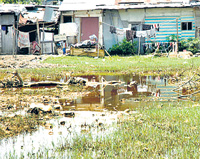
Little sting in battle against mosquito menace
Based on previous patterns of dengue outbreaks, 2008 is being considered a high risk year, with the first three months showing a significant increase in the number of dengue related cases compared to the first three months of last year. So far 1806 dengue cases, including five deaths, have been reported for this year, compared to the1499 cases reported during the first three months of last year. Health Ministry, Epidemiology Unit Director Nihal Abeysinghe said Chikungunya is also spreading especially in the North Central Province, while there is an increase in the incidence of other viral flus too. He said a change in weather was one of the main factors for the spread of mosquito-borne diseases.
Meanwhile Health Ministry’s Environmental and Occupational Health Director C.K. Shanmugarajah, said one of the main complaints of the public was that local authorities are doing little to destroy mosquito breeding places thus failing to control the spread of mosquito-borne diseases. “Local authorities tend to take immediate measures following warnings of outbreaks, but after a while the urgency is forgotten. Stagnant water in bare lands, poor garbage management and failure to regularly clean canals soon become ideal mosquito breeding grounds,” he said. Dr. Shanmugarajah who was also a member of the team that formulated the Prevention of Mosquito Breeding Act, said, although the Act was passed in Parliament almost a year ago, regulations against offenders are yet to be gazetted. He said a draft copy of some of the regulations have been handed over to the Legal Draftsmen’s Department. Once this is in place, the Director General of Health would be empowered to take action even against local authorities, in case of negligence.According to the Dengue Control Unit the majority of the cases for this year were reported from Colombo, Gampaha and Kalutara districts, while nine other districts including Kandy, Matale, Ratnapura, Kurunegala, Puttalam, Kegalle, Anuradhapura, Trincomalee and Matara have been identified as high risk areas The National Coordinator of the Dengue Control Unit of the Health Ministry, Dr. Lakshmi de Silva, said the main strategy in controlling dengue should be to reduce breeding sites.“Containers, discarded tyres and bare land are the main breeding grounds in all the provinces, especially the Western Province. With the rainfall the situation is worse,” she said. Commenting on dengue-controlling programmes, Dr. Silva said they are implemented through local authorities based on project proposals sent by Medical Officers of Health (MOHs) islandwide. She said these programmes are funded by the Health Ministry, foreign donor agencies, NGOs and sometimes even local authorities. This year, the Health Ministry and the World Health Organization (WHO) together have allocated Rs. 25 million for the Dengue Control Programme.
Colombo district has reported the highest number of dengue cases this year--389--with Wellawatta, Bambalapitiya and Colombo 7 being the worst- hit areas while Modera and Mattakuliya accounted for the most number of Filaria cases. Although according to health Officials, Rs. 400 million is spent on mosquito eradication programmes, islandwide, people complain these are ineffective mainly due to negligence by local authorities. A case in point is the Prajashala Park on Arunodhaya Mawatha in Rajagiriya. This was once a children’s playground but now it’s a massive dumping site. Soil, dredged from the canal has been dumped in this playground and the stagnant water as a result of the recent rain has turned the place into a major mosquito breeding place affecting around 5000 families. R. B. Gunatilake, who lives just opposite the park, said that PHIs’(Public Health Inspectors) rarely visit the area and when they do they merely look at the place but do little. “This area is full of mosquitoes throughout the day and one cannot survive without a mosquito net. Almost all the drains are blocked and the stagnant water has made the situation worse. Most of our children are suffering from mosquito-borne diseases,” he said. The polluted canal in Kirulapone too has become a breeding grounds for mosquitoes.“Local authorities sometimes fumigate the area, but this is of little use if they do not stop people from dumping garbage into the canal. Main culprits are passers-by who throw their garbage into the canal,” Mahinda Ekanayake, a resident of Kirulapone said. |
|
||||||
|| Front
Page | News | Editorial | Columns | Sports | Plus | Financial
Times | International | Mirror | TV
Times | Funday
Times || |
| |
Reproduction of articles permitted when used without any alterations to contents and a link to the source page.
|
© Copyright
2008 | Wijeya
Newspapers Ltd.Colombo. Sri Lanka. All Rights Reserved. |

